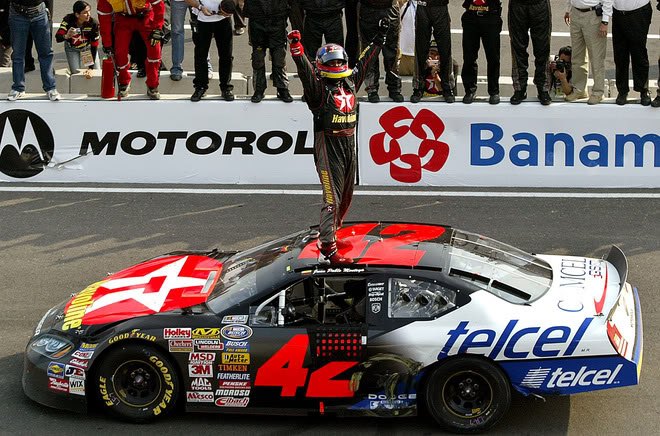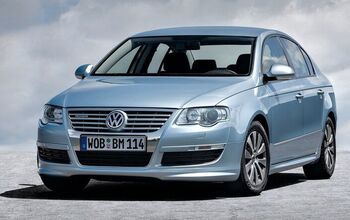NASCAR Tech: It's A Lot More Than You Think

I’ve heard a lot of derisive comments about NASCAR lately on this site, many of them from people — my fellow racers and fast-road drivers — who should know better. While it’s true that the common template is a disgrace, the idea that NASCAR is a low-tech ghetto compared to the oh-so-modern sports-car series like the ALMS is, to put it mildly, false. There’s a reason that the abortive USF1 team wanted to locate near the NASCAR guys. It’s where the tech is. Click the jump to find out why racing NASCAR takes more brainpower than any Touring Car or prototype series out there…
Let’s start with engines. NASCAR just runs old small-block Chevys with carbs, right? Not so simple. Let’s compare F1 engines to NASCAR engines using Brake Mean Effective Pressure (BMEP) and Mean Piston Speed (MPS). These are measurements of how hard and fast an engine runs. Surely the F1 engine runs at pressures and piston speeds that are FAR beyond those of NASCAR, right?
According to Race Engine Technology, The BMEP of the Formula One engine at peak torque (table line 13) is 15.17 bar while the Cup engine produces a peak torque BMEP of 15.12 bar (0.3 % less). At peak power, the Formula One BMEP value (table line 22) is 14.6 bar while the Cup figure is 14.0 bar (4.1% less). As far as piston speed,
Even more revealing, at peak power RPM (table line 19) the Formula One engine MPS is 25.5 m/s (5025 ft/min), while that of the Cup engine is less than 3% lower at 24.8 m/s (4875 ft/min). At redline, the Formula One MPS is 26.5 m/sec, while the Cup MPS is a stunning 27.5 m/sec. To put those numbers in perspective, Professor Gordon Blair wrote (Race Engine Technology, issue 27) that 26.5 m/sec was the highest he had seen.
How’d those stupid hicks get their pistons to move faster than the mighty engine builders of Formula One? Note that some street cars reach into the same piston-speed zone, but they are incapable of operating under those BMEPs for very long. F1 engines run with much greater friction to create those piston speeds because their crankshafts run faster… but NASCAR engines have a much longer stroke, thus imposing a much greater acceleration load on the parts.
Now let’s talk aero. With millions of dollars at stake, aerodynamic improvements are critical. ALMS designers can draw almost anything they want, because the rules are loose. F1 presents a much stronger challenge, which is why Nick Wirth’s CFD approach was so dominating with the LC75-based Acura ARX but has struggled to keep Virgin Racing from the bottom of the field. The limits to what you can “draw” in F1 are considerable, and any bright ideas don’t last too long, as was shown with the F-duct and flexible front wing that arrived this year and were promptly written out of next year’s rulebook.
NASCAR teams have an even tougher job. They are limited to a common template, so they can’t change the aero at all. Right? If that’s the case, then why is the Holy Grail of aerodynamic testing — the “coastdown tunnel” — rumored to exist right now, in the hands of Chip Ganassi? The answer is that NASCAR teams work at a level of aerodynamics unknown outside the world of military aviation: surface composition aero. A NASCAR Car of Tomorrow is a matrix of multiple surfaces, some smooth, some rough, all designed to manage the airflow at the near-molecular level. Jimmie Johnson’s remarkable pace last year? All the product of rough-surface aero development.
We could go on and talk about the massive effort put into the “little things” of racing — from the kind of brake compounds required to slow a NASCAR-sized sedan from 195+mph to the astoundingly complex calculations of shock absorber valving required to keep a car that big from becoming murderously loose on a bumpy superspeedway — but I hope I’ve encouraged at least some of you to go take a look at what actually happens in NASCAR. It may not be Formula One, but it’s not ALMS P2 either.

More by Jack Baruth
Latest Car Reviews
Read moreLatest Product Reviews
Read moreRecent Comments
- Golden2husky The biggest hurdle for us would be the lack of a good charging network for road tripping as we are at the point in our lives that we will be traveling quite a bit. I'd rather pay more for longer range so the cheaper models would probably not make the cut. Improve the charging infrastructure and I'm certainly going to give one a try. This is more important that a lowish entry price IMHO.
- Add Lightness I have nothing against paying more to get quality (think Toyota vs Chryco) but hate all the silly, non-mandated 'stuff' that automakers load onto cars based on what non-gearhead focus groups tell them they need to have in a car. I blame focus groups for automatic everything and double drivetrains (AWD) that really never gets used 98% of the time. The other 2% of the time, one goes looking for a place to need it to rationanalize the purchase.
- Ger65691276 I would never buy an electric car never in my lifetime I will gas is my way of going electric is not green email
- GregLocock Not as my primary vehicle no, although like all the rich people who are currently subsidised by poor people, I'd buy one as a runabout for town.
- Jalop1991 is this anything like a cheap high end German car?


































Comments
Join the conversation
Nothing beats dual over head cam 4 valves per cylinder, and now 5 valve if both engine blocks are identical in cubic inch. The increase in power naturally aspirated is astounding. Honda didn't reinvent the wheel here in 1979, being Alfa Romero was at in the 60's. They simply perfected it like they always do anytime we think we developed something worth while. There is 1/2 the load bearing forces of the valve train to start with having to only open them 1/2 as deep into the head. No rocker arms with direct contact shim buckets off the cams. No mention of management being it's always being upgraded to control what it eats and breaths. As for stroke piston speed, short stroke is 1/2 the piston speed, far less crank mass and bearing forces making them last and fast. Like 2L motors making 800Hp and stay together, incredible. I love long stroke torque as much as anyone, and was the deciding factor with Honda's designed long stroke Hemi size piston'd 1800vtx over Harley's long stroke 1450's design. Simply High Tech from the ground up. Push rod motors are about as high tech as Stone Hedge. This is where the US Mfg's poorly engineered designs are getting pushed out of the way. If not for the re-labeled Mazda's at Ford, it would be far worse. I have to admit, as a F1 freak since the early 80's, then met and talked to one the drivers at his camp site. My first question answered blew my mind. Simply asked what the max down force was at the rear wing. Instant lock jaw when he said 5000 lbs, or 2500 kg. Then it all made sense from there how the turning speeds look magic. If it were allowed, I'd add synced rudders to steering. Now see impossible physics. Recent venture into F1 as invited crew member is so much more tech than one can imagine at every inch. Simply a F15 with it's wings ripped off. I attend some Nascar, and trick is not to be down wind, and the sardine seating is insane. This group and designers apparently don't get it, or just don't care. Just pack in as much cash per square inch is all that matters. No pit access with so much chaos & liability. F1, no problem. I lasted twenty minutes, then got out of $100 seats to wander with camera. It's just not the same or exciting like it was seeing your Dad's 440 going the limit when Chrysler ruled the 60's-70's. I would have to agree with others now on SuperBike, Motogp, Rally, Sprint-WoO's. Seeing the image results of F1 in Japan at night last season looks like it will be successful even at $1200 entry fee. Hopefully the soap opera issues behind the scenes stay that way. Cheers